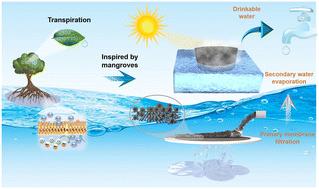当前位置:
X-MOL 学术
›
Environ. Sci.: Nano
›
论文详情
Our official English website, www.x-mol.net, welcomes your
feedback! (Note: you will need to create a separate account there.)
Amphiphilic engineering of MoS2–g–C3N4 nanocomposites into a mangrove-inspired cascade system for sustainable drinking water production
Environmental Science: Nano ( IF 5.8 ) Pub Date : 2024-10-16 , DOI: 10.1039/d4en00633j Sichen Liu, Haotian Wang, Yumeng Xiao, David G. Calatayud, Boyang Mao, Gaoqi Zhang, Chenhui Yang, Lidong Wang, Meng Li
Environmental Science: Nano ( IF 5.8 ) Pub Date : 2024-10-16 , DOI: 10.1039/d4en00633j Sichen Liu, Haotian Wang, Yumeng Xiao, David G. Calatayud, Boyang Mao, Gaoqi Zhang, Chenhui Yang, Lidong Wang, Meng Li

|
Drinking water contamination and water shortages are seriously exacerbated by industrial wastewater discharge. However, due to the high complexity of wastewater treatment systems, effective high-concentration pollutant removal and simplified wastewater recycling remain major challenges. Inspired by mangrove interconnected purification mechanisms, a novel cascade water treatment system has been developed using MoS2–g–C3N4 (MoG), an amphiphilic material, as the main and single component to directly produce drinking water from wastewater with high efficiency. This cascade system integrates membrane filtration and solar-powered water evaporation processes to produce clean water, while also overcoming the requirement for less polluted source water that is typically required for standalone solar evaporation-based clean water production. The MoG membrane, featuring an amphiphilic platform, exhibits a high removal rate for organic and heavy metal contaminants and achieves a water flow of 966 L m−2 h−1 bar−1 and an 80% efficiency in pollutant removal. The MoG-based aerogel enables nano- and micro-channels and exhibits a clean water production rate of 1.48 kg m−2 h−1 under 1 sun irradiation. The compact cascade system for practical use can produce drinking water that meets WHO standards from heavily polluted wastewater with an average hourly water production rate of 1.39 kg m−2 h−1. Life cycle assessment confirms that the cascade system displays significant environmental profile improvement with reduced CO2 equivalent (CO2e) levels with only 1/25 of that observed in conventional water treatment systems.
中文翻译:

将 MoS2–g–C3N4 纳米复合材料两亲性工程化成受红树林启发的梯级系统,用于可持续饮用水生产
工业废水排放严重加剧了饮用水污染和水资源短缺。然而,由于废水处理系统的高度复杂性,有效的高浓度污染物去除和简化废水回收仍然是主要挑战。受红树林互联净化机制的启发,以两亲性材料 MoS2–g–C3N4 (MoG) 为主要和单一成分,开发了一种新型梯级水处理系统,可直接从废水中高效生产饮用水。该复叠系统集成了膜过滤和太阳能水蒸发过程,以产生清洁水,同时还克服了独立基于太阳能蒸发的清洁水生产通常需要的污染较少的源水的要求。MoG 膜具有两亲性平台,对有机和重金属污染物表现出高去除率,水流量为 966 L m-2 h-1 bar-1,污染物去除效率为 80%。基于 MoG 的气凝胶可实现纳米和微通道,并在 1 次阳光照射下表现出 1.48 kg m-2 h-1 的清洁水产生率。实用的紧凑型复叠系统可以从重污染废水中生产符合 WHO 标准的饮用水,平均每小时产水量为 1.39 kg m-2 h-1。 生命周期评估证实,随着 CO2 当量 (CO2e) 水平降低,复叠系统显示出显著的环境状况改善,而观察到的水平仅为传统水处理系统的 1/25。
更新日期:2024-10-16
中文翻译:

将 MoS2–g–C3N4 纳米复合材料两亲性工程化成受红树林启发的梯级系统,用于可持续饮用水生产
工业废水排放严重加剧了饮用水污染和水资源短缺。然而,由于废水处理系统的高度复杂性,有效的高浓度污染物去除和简化废水回收仍然是主要挑战。受红树林互联净化机制的启发,以两亲性材料 MoS2–g–C3N4 (MoG) 为主要和单一成分,开发了一种新型梯级水处理系统,可直接从废水中高效生产饮用水。该复叠系统集成了膜过滤和太阳能水蒸发过程,以产生清洁水,同时还克服了独立基于太阳能蒸发的清洁水生产通常需要的污染较少的源水的要求。MoG 膜具有两亲性平台,对有机和重金属污染物表现出高去除率,水流量为 966 L m-2 h-1 bar-1,污染物去除效率为 80%。基于 MoG 的气凝胶可实现纳米和微通道,并在 1 次阳光照射下表现出 1.48 kg m-2 h-1 的清洁水产生率。实用的紧凑型复叠系统可以从重污染废水中生产符合 WHO 标准的饮用水,平均每小时产水量为 1.39 kg m-2 h-1。 生命周期评估证实,随着 CO2 当量 (CO2e) 水平降低,复叠系统显示出显著的环境状况改善,而观察到的水平仅为传统水处理系统的 1/25。






























 京公网安备 11010802027423号
京公网安备 11010802027423号